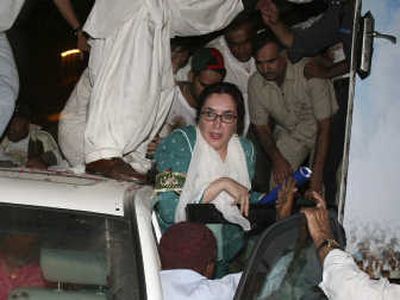Bloody return for Bhutto

KARACHI, Pakistan – What had been a joyous homecoming Thursday for former Prime Minister Benazir Bhutto turned into a scene of blood and chaos hours later as a pair of blasts ripped through the crowd surrounding her convoy, killing more than 125 people and injuring at least 250 others, according to police and hospital officials.
Bhutto herself was unhurt, her party said.
More than 150,000 people had packed the streets of this port city to greet the 54-year-old former leader, who returned home to a raucous welcome after eight years in self-imposed exile.
The explosions hit shortly after midnight as her convoy was moving slowly through the throng toward the mausoleum of Pakistan’s founding father, Mohammed Ali Jinnah, where Bhutto was to have delivered a triumphal address today.
Screams erupted from the close-packed crowd as the two explosions rang out less than 20 yards from the truck carrying Bhutto. The first blast was followed by a much larger one, witnesses said, and flames leaped into the air. As charred bodies and the writhing wounded lay in the streets, Bhutto was whisked from the scene by aides and security officials.
There was no immediate claim of responsibility for the attacks, but before her return, Islamic militants had threatened violence against Bhutto, who is seen as a pro-Western moderate. Pakistani cities have been hit hard in the past year by suicide attacks, but this was by far the deadliest.
Until the blasts, the focus of the homecoming had been the highly fraught relationship between Bhutto and President Pervez Musharraf, who remains the chief of Pakistan’s military. The two have been trying, with the blessing of the United States, to negotiate a power-sharing arrangement.
Musharraf has signaled determination to retain a share of power for himself, in uniform or not. Bhutto, for her part, has been trying to soothe anger among her own supporters over dealing with a man she has described as a dictator.
The attacks, and the grisly tableau left behind, quickly overshadowed that. Streets near the blast site, either darkened or eerily lit by floodlights, were carpeted with broken glass, plastic sandals and bloodied posters of Bhutto.
Bhutto was taken to Bilawal House, her residential compound in downtown Karachi that is adjacent to her party headquarters. Photographs by the Associated Press showed her being helped from her vehicle in the blasts’ aftermath, appearing dazed but uninjured.
Emergency vehicles, with the crowds around them, ferried the wounded and dead to nearby hospitals in the city center. Because it was difficult for ambulances to make their way through the throng, some men picked up wounded people and slung them across motorbikes. Others carried the injured in their arms.
At the city’s main Jinnah Hospital, shrouded corpses were laid in rows outside the emergency entrance as doctors and paramedics hurried to meet arriving casualties. A Pakistani cameraman and more than a dozen police officers were reported to be among the dead. Police vehicles escorting the convoy appeared to have taken the brunt of the blasts.
Bhutto’s convoy from the airport had been on the road for more than nine hours when the attack occurred, slowly making its way to the city center along Karachi’s main boulevard. By midnight, it had covered only about half the 10-mile distance to the mausoleum.
In hours of waiting under a blazing sun in Karachi, the country’s largest city, crowds of Bhutto’s followers sang and danced to amplified music, waving the green-red-and-black flag of the Pakistan People’s Party. Her image was plastered onto every available surface – cement walls, tree trunks, lampposts, the backs of chugging motorized rickshaws.
“She is our sister, our mother, our friend, our protector,” said Abdullah Rehman, a 42-year-old laborer who spent the night on a thin mat in hopes of catching a glimpse of Bhutto.
Making her way down the jetway after her commercial flight arrived Thursday afternoon from the Persian Gulf city of Dubai, Bhutto lifted her hands in a prayerful gesture and raised her face to the sky, her familiar white veil slipping backward over her black hair. Tears sprang to her eyes as she stepped onto the tarmac.
“I feel proud, so very proud of the people of Pakistan,” Bhutto told reporters.
Bhutto’s arrival comes at a moment when Musharraf’s grip on leadership is at the weakest since he seized power in a 1999 coup. His popularity is at an all-time low, and his re-election earlier in October as president by Pakistani lawmakers is under legal challenge by opponents.
But the 64-year-old military man is far from a spent force. He appears to retain both the loyalty of Pakistan’s powerful military and the patronage of the United States, which nudged the two toward a deal that would allow Bhutto to return home without facing corruption charges stemming from her previous two terms as prime minister.
The Bush administration sees both Musharraf and Bhutto as Western-friendly moderates who could be counted upon to fight against Taliban and al-Qaida militants who have ensconced themselves in Pakistan’s tribal areas along the Afghanistan border.
Mindful, perhaps, of resentment in Pakistan over perceived American meddling in domestic politics, the White House declined to comment directly on Bhutto’s return. Spokeswoman Dana Perino said the United States hoped for a “peaceful, democratic Pakistan, an Islamic state that is a moderate force in the region, and one that can be an ally to help us fight extremism and radicalism.”
Later, U.S. officials condemned the attacks.